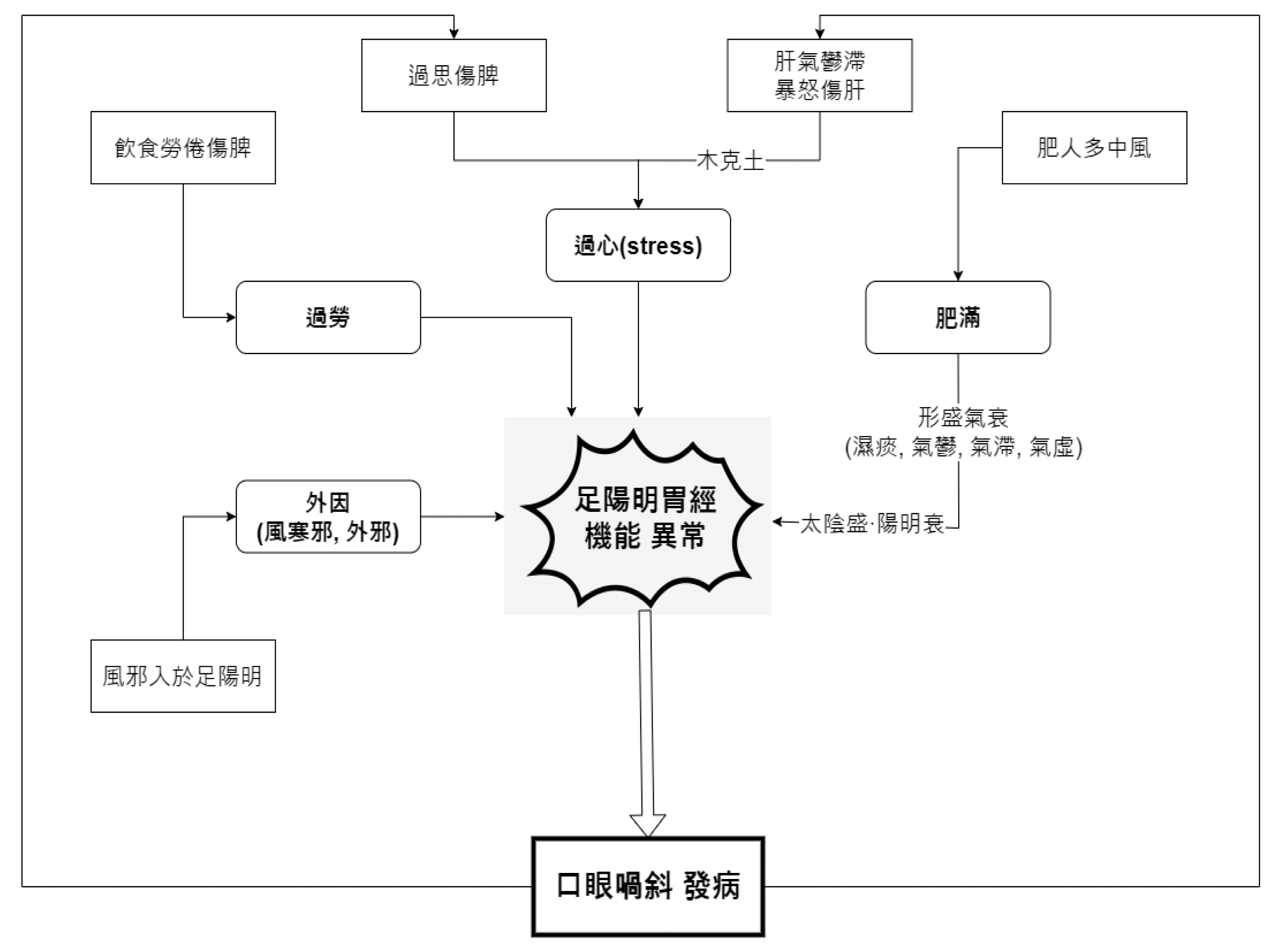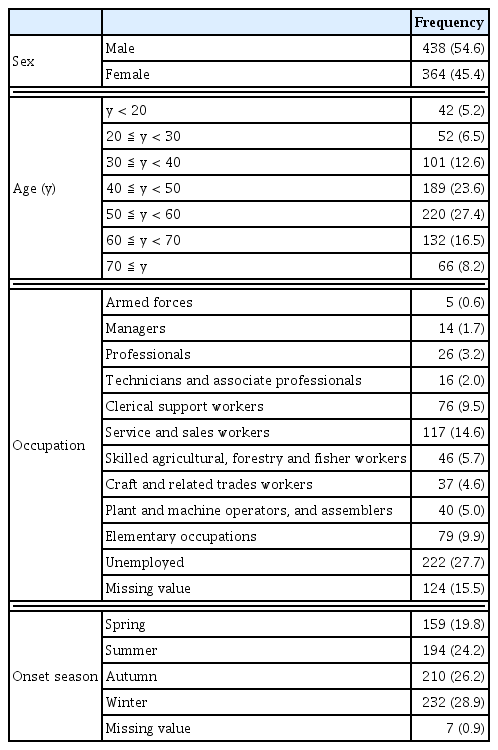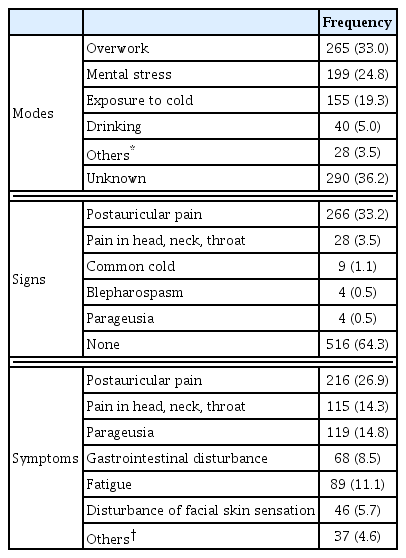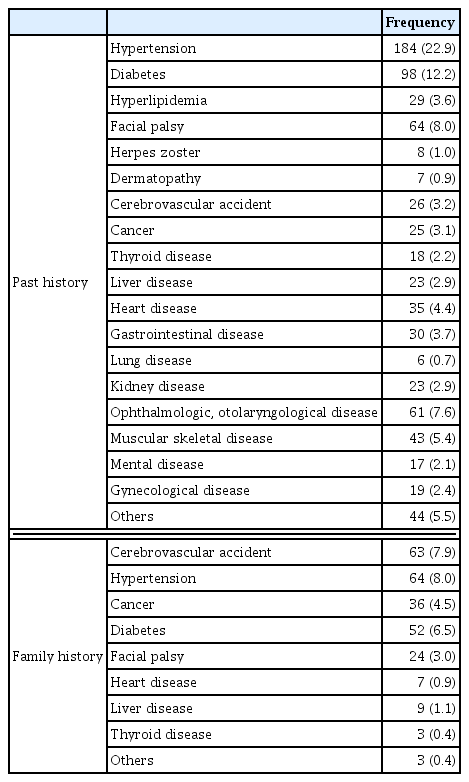References
1. Lee H.Y., Ryu E.W., Park S.W., Kim J.H., Park J.H.. 2011;Analysis of Associated Symptoms of Bell's Palsy. Korean Journal of Otorhinolaryngology-Head and Neck Surgery 54(10):683–687.
10.3342/kjorl-hns.2011.54.10.683.
2. Slavkin H.C.. 1999;The significance of a human smile: Observations on Bell's palsy. Journal of the American Dental Association 130(2):269–272.
10.14219/jada.archive.1999.0141.
3. Atzema C., Goldman R.D.. 2006;Should we use steroids to treat children with Bell's palsy? Canadian Family Physician 52(3):313–314.
16540094.
4. Shaw M., Nazir F., Bone I.. 2005;Bell’s Palsy: A Study of the Treatment Advice Given by Neurologists. Journal of Neurology, Neurosurgery, and Psychiatry 76(2):293–294.
10.1136/jnnp.2004.046169.
5. Holland N.J., Weiner G.M.. 2004;Recent Developments in Bell’s Palsy. British Medical Journal 329(7465):553–557.
10.1136/bmj.329.7465.553.
6. Marson A.G., Salinas R.. 2000;Bell’s Palsy. Western Journal of Medicine 173(4):266–268.
10.1136/ewjm.173.4.266.
7. Peitersen E.. 2002;Bell’s Palsy: The Spontaneous Course of 2,500 Peripheral Facial Nerve Palsies of Different Etiologies. Acta Oto-Laryngologica Supplementum 549:4–30.
10.1080/000164802760370753.
8. Prescott C.A.. 1988;Idiopathic Facial Nerve Palsy (the Effect of Treatment with Steroids). The Journal of Laryngology and Otology 102(5):403–407.
10.1017/S0022215100109667.
9. Korean Acupuncture & Moxibustion Medicine Society Textbook Publish Committee Compilation. 2020. The Acupuncture and Moxibustion Medicine Seoul, South Korea: HANMI Medical Publishing. p. 625–629.
10. Wang B.. 1995. Huang Di Nei Jing Ling Shu Seoul, South Korea: Cheng Fu Publishing. p. 57. p. 188.
11. Lou Y.. 1987. Yi Xue Gang Mu Beijing, China: Ren Min Wei Sheng Chu Ban She. p. 274. p. 320. p. 321.
12. Chao Y.F.. 1976. Zhu Bing Yuan Hou Lun Taipei, Taiwan: Ji Wen Shu Ju. p. 3.
13. House J.W., Brackmann D.E.. 1985;Facial Nerve Grading System. Otorhinolaryngology-Head and Neck Surgery 93(2):146–7.
10.1177/019459988509300202.
14. Kweon S.H., Kim Y.N., Jang M.J., Kim Y.J., Kim K.R., Choi S.H., Oh K.W.. 2014;Data Resource Profile: The Korea National Health and Nutrition Examination Survey (KNHANES). International Journal of Epidemiology 43(1):69–77.
10.1093/ije/dyt228.
15. World health organization/International association for the study of obesity/International obesity taskforce. 2000. The Asia-Pacific Perspective: Redefining Obesity and Its Treatment Melbourne, Australia: Health Communications Australia. p. 18.
16. Lee W.S., Kim J.. 2009;Facial nerve paralysis and surgical management. Journal of the Korean Medical Association 52(8):807–818.
10.5124/jkma.2009.52.8.807.
17. Lee J.A., Kim J.U., Choi J., et al. Clinical Practice Guidelines of Korean Medicine for Facial Palsy: an Evidence-based Approach. Eur J Integr Med 2016;8:176–81.
18. Finsterer J.. 2008;Management of Peripheral Facial Nerve Palsy. European Archives of Oto-Rhino-Laryngology 265(6):743–752.
10.1007/s00405-007-0556-3.
19. Li G.. 1987. Yi Xue Fa Ming Huo Fa Ji Yao Beijing, China: Zhong Yi Gu Ji Chu Ban She. p. 37.
20. Chen X.Y.. 1991. Yi Xue Cong Zhong Lu Beijing, China: Shanghai Ke Xue Ji Shu Chu Ban She. p. 3–4.
21. Qin J.M.. Unknown. Zheng Yin Mai Zhi China: Xuan Feng Chu Ban She. p. 32.
22. Yang X.H.. 1986. Jin Gui Yao Lue Zhu Shi Taipei, Taiwan: Zheng Zhong Shu Ju. p. 15.
23. Qin Y.R.. Nan Jing Ji Zhu Beijing, China: Ren Min Wei Sheng Chu Ban She. p. 268.
24. Lee B.. 1996. Yixue rumen (IV) 8th editionth ed. Seoul, South Korea: Namsan-dang. p. 67.
25. Wang B.. 1994. Huang Di Nei Jing Su Wen Seoul, South Korea: Seong Bu Sa. p. 87–91.
26. Zhang J.B.. 1994. Jing Yue Quan Shu Beijing, China: Ren Min Wei Sheng Chu Ban She. p. 231.
27. Su Liu Z. 1983. Su Wen Xuan Ji Yuan Bing Shi Beijing, China: Ren Min Wei Sheng Chu Ban She. p. 189.





